
Marquetry is the art and craft of applying pieces of veneer to a structure to form decorative patterns or designs. The technique may be applied to case furniture or even seat furniture, to decorative small objects with smooth, veneerable surfaces or to freestanding pictorial panels appreciated in their own right.

The Sienese school of painting flourished in Siena, Italy, between the 13th and 15th centuries. Its most important artists include Duccio, whose work shows Byzantine influence, his pupil Simone Martini, the brothers Pietro and Ambrogio Lorenzetti and Domenico and Taddeo di Bartolo, Sassetta, and Matteo di Giovanni.
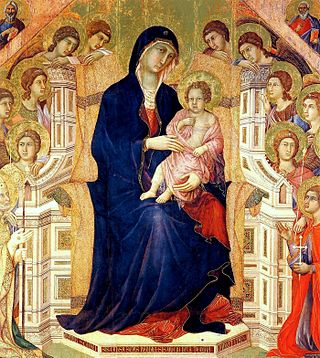
Duccio di Buoninsegna, commonly known as just Duccio, was an Italian painter active in Siena, Tuscany, in the late 13th and early 14th century. He was hired throughout his life to complete many important works in government and religious buildings around Italy. Duccio is considered one of the greatest Italian painters of the Middle Ages, and is credited with creating the painting styles of Trecento and the Sienese school. He also contributed significantly to the Sienese Gothic style.
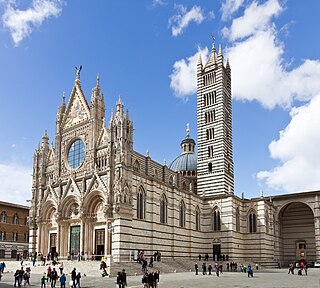
Siena Cathedral is a medieval church in Siena, Italy, dedicated from its earliest days as a Roman Catholic Marian church, and now dedicated to the Assumption of Mary.
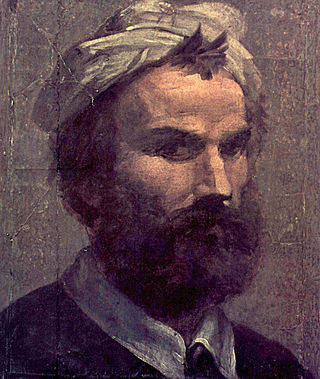
Domenico di Pace Beccafumi was an Italian Renaissance-Mannerist painter active predominantly in Siena. He is considered one of the last undiluted representatives of the Sienese school of painting.

Tunbridge ware is a form of decoratively inlaid woodwork, typically in the form of boxes, that is characteristic of Tonbridge and the spa town of Royal Tunbridge Wells in Kent in the 18th and 19th centuries. The decoration typically consists of a mosaic of many very small pieces of different coloured woods that form a pictorial vignette. Shaped rods and slivers of wood were first carefully glued together, then cut into many thin slices of identical pictorial veneer with a fine saw. Elaborately striped and feathered bandings for framing were pre-formed in a similar fashion.

Pietra dura, pietre dure or intarsia lapidary, called parchin kari or parchinkari in the Indian Subcontinent, is a term for the inlay technique of using cut and fitted, highly polished colored stones to create images. It is considered a decorative art. The stonework, after the work is assembled loosely, is glued stone-by-stone to a substrate after having previously been "sliced and cut in different shape sections, and then assembled together so precisely that the contact between each section was practically invisible". Stability was achieved by grooving the undersides of the stones so that they interlocked, rather like a jigsaw puzzle, with everything held tautly in place by an encircling 'frame'. Many different colored stones, particularly marbles, were used, along with semiprecious, and even precious stones. It first appeared in Rome in the 16th century, reaching its full maturity in Florence. Pietra dura items are generally crafted on green, white or black marble base stones. Typically, the resulting panel is completely flat, but some examples where the image is in low relief were made, taking the work more into the area of hardstone carving.
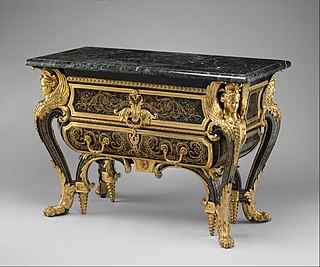
André-Charles Boulle, le joailler du meuble, became the most famous French cabinetmaker and the preeminent artist in the field of marquetry, also known as "inlay". Boulle was "the most remarkable of all French cabinetmakers". Jean-Baptiste Colbert recommended him to Louis XIV of France, the "Sun King", as "the most skilled craftsman in his profession". Over the centuries since his death, his name and that of his family has become associated with the art he perfected, the inlay of tortoiseshell, brass and pewter into ebony. It has become known as Boulle work, and the École Boulle, a college of fine arts and crafts and applied arts in Paris, continues today to bear testimony to his enduring art, the art of inlay.

Domenico di Bartolo, born in Asciano, Siena, was a Sienese painter of the early Renaissance period. In the Lives of the Most Excellent Painters, Sculptors, and Architects, Giorgio Vasari says that Domenico was the nephew of Taddeo di Bartolo. Influenced by the new Florentine style of painting, Domenico di Bartolo was the only Sienese painter of his time to receive commissions from clients in Florence. In Siena, he was employed by Lorenzo di Pietro, to help execute the fresco The Care of the Sick, in the Pilgrim's Hall of the Hospital of Santa Maria della Scala.
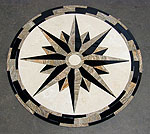
A floor medallion is generally a centerpiece of flooring design that can be made with various flooring materials, including natural stone, wood, metal, tile, glass or a variety of other materials suitable for flooring. The pattern can be created using various methods such as mosaic, intarsia, and marquetry.
Sano di Pietro or Ansano di Pietro di Mencio (1405–1481) was an Italian painter of the Sienese school of painting. He was active for about half a century during the Quattrocento period and his contemporaries included Giovanni di Paolo and Sassetta.
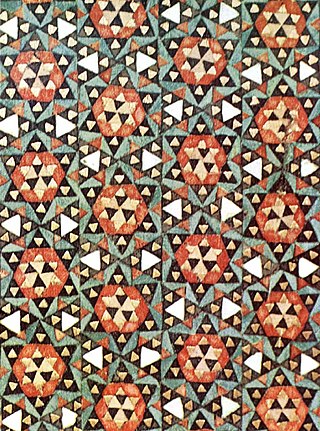
Khātam is an ancient Persian technique of inlaying. It is a version of marquetry where art forms are made by decorating the surface of wooden articles with delicate pieces of wood, bone and metal precisely-cut intricate geometric patterns. Khatam-kari (خاتمکاری) or khatam-bandi (خاتمبندی) refers to the art of crafting a khatam. Common materials used in the construction of inlaid articles are gold, silver, brass, aluminum and twisted wire.

Opus sectile is a form of pietra dura popularized in the ancient and medieval Roman world where materials were cut and inlaid into walls and floors to make a picture or pattern. Common materials were marble, mother of pearl, and glass. The materials were cut in thin pieces, polished, then trimmed further according to a chosen pattern. Unlike tessellated mosaic techniques, where the placement of very small uniformly sized pieces forms a picture, opus sectile pieces are much larger and can be shaped to define large parts of the design.
The following outline is provided as an overview of and topical guide to crafts:
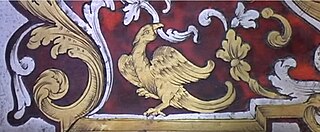
Inlay covers a range of techniques in sculpture and the decorative arts for inserting pieces of contrasting, often colored materials into depressions in a base object to form ornament or pictures that normally are flush with the matrix. A great range of materials have been used both for the base or matrix and for the inlays inserted into it. Inlay is commonly used in the production of decorative furniture, where pieces of colored wood, precious metals or even diamonds are inserted into the surface of the carcass using various matrices including clear coats and varnishes. Lutherie inlays are frequently used as decoration and marking on musical instruments, particularly the smaller strings.
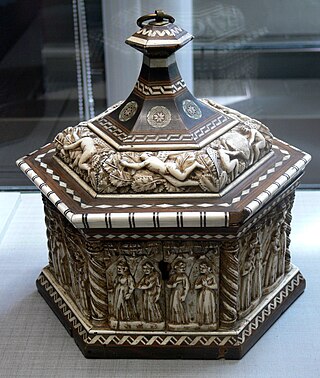
Certosina is a decorative art technique of inlaying used widely in the Italian Renaissance period. Similar to marquetry, it uses small pieces of wood, bone, ivory, metal, or mother-of-pearl to create inlaid geometric patterns on a wood base. The term comes from Carthusian monasteries, probably the Certosa di Pavia, where the technique was used in ornamenting an altarpiece by the Embriachi workshop.
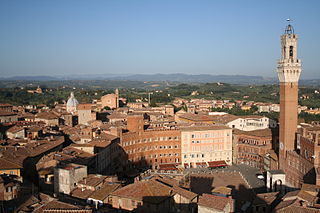
Siena is a city in Tuscany, Italy. It is the capital of the province of Siena. Siena is the 12th largest city in the region by number of inhabitants, with a population of 53,062 as of 2022.

Niccolò di Buonaccorso, also Niccolò di Niccolò di Buonaccorso or Bonaccorso, was an Italian painter and one of the most prominent Sienese painters of the 14th century. The small body of his work that survives shows the artist's highly refined miniaturist technique. The artist was also briefly involved in local politics.

Andrea di Niccolò, also Andrea di Niccolò di Giacomo, (1440–1514) was an Italian painter of the Sienese School.
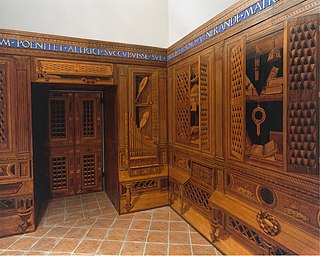
The Metropolitan Museum of Art has on display a complete studio from the Palazzo ducale di Gubbio. Consisting of period woodwork from late 15th century Italy, the studio was commissioned for Federico da Montefeltro.




















